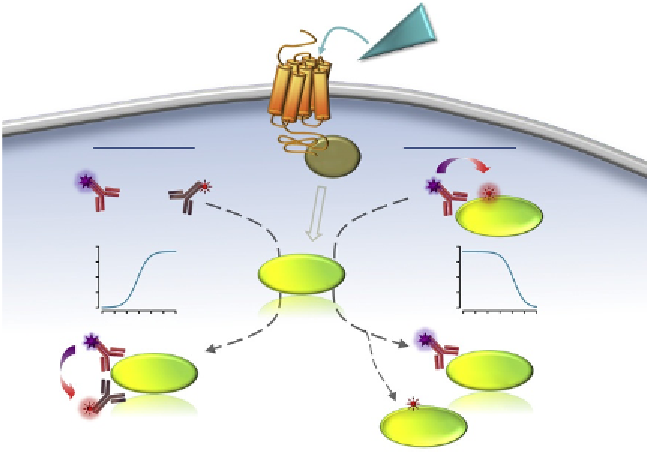Biology Reference
In-Depth Information
2- Competition assay
1- Sandwich assay
G
protein
Fluorescently
labeled kit
messenger
Second
messenger
messenger
log[compound] (M)
log[compound] (M)
Second
messenger
Second
messenger
messenger
messenger
Fluorescently
labeled kit
messenger
Figure 7.2 Sandwich and competitive assay format. In a sandwich assay, normalized
FRET signals are generated through energy transfer between two antibodies, one la-
beled with a donor and the other with an acceptor, and recognizing the target to assay
at different regions. The larger the amount of target produced, the higher the normal-
ized FRET signal. In a competitive assay, the target generated through G protein activa-
tion competes with an acceptor-labeled version of itself for binding to a donor-labeled
antibody, decreasing the possible energy transfer. Thus, the normalized FRET signal
decreases as more of the target is produced.
The TR-FRET signal measured ratiometrically is then proportional to the
quantity of target produced, and it can sometimes be translated into a proper
concentration of target produced, as the quantity of each labeled antibodies
introduced is controlled.
In a competitive assay, the target (e.g., a metabolite such as cAMP) pro-
duced through a biological event competes with an acceptor-labeled version
of it (usually provided in the kit used) for binding to a donor-labeled anti-
body. Thus, the TR-FRET signal measured decreases as more endogenous
target is produced because it displaces the labeled target, separating the two
fluorophores which can no longer transfer energy to each other. Again, for
some assays, the TR-FRET signal measured ratiometrically is proportional
to the quantity of target produced and can indicate a proper concentration of
target in the medium.
These two formats have been deployed to assay many metabolites and
targets in the GPCR activation cascade and will be listed below.


Search WWH ::

Custom Search